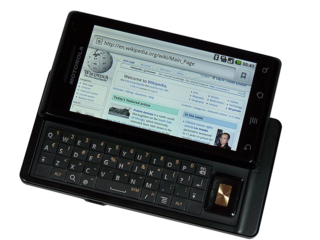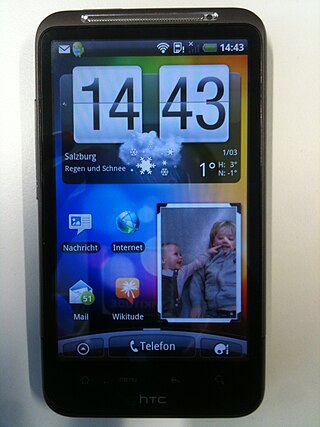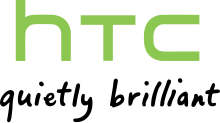
HTC Hero is the third phone manufactured by HTC running the Android platform, announced on June 24, 2009 in London.

HTC is the original design manufacturer for many Android and Windows Phone-based smartphones and PDAs. Brands that market or previously marketed HTC-manufactured products include Dell, Fujitsu Siemens, HP/Compaq, i-mate, Krome, O2, Palm, Sharp Corporation, and UTStarcom. HTC also manufactures ultra-mobile PCs, and is also the manufacturer of the Nexus One and Nexus 9, a smartphone and tablet designed and branded by Google, respectively.

The Motorola Droid is an Internet and multimedia-enabled smartphone designed by Motorola, which runs Google's Android operating system. The Droid had been publicized under the codenames Sholes and Tao and the model number A855. In Latin America and Europe, the model number is A853 (Milestone), and in Mexico, the model number is A854 (Motoroi). Due to the ambiguity with newer phones with similar names, it is also commonly known as the DROID 1. The brand name Droid is a trademark of Lucasfilm licensed to Verizon Wireless.

The HTC Desire is the first smartphone of the Desire series developed by HTC. It was announced on 16 February 2010 and released in Europe and Australia in the second quarter of the same year. The HTC Desire was HTC's third flagship phone running Android 2.1 Eclair which can be upgraded to 2.2 Froyo or 2.3 Gingerbread. Internally it bears a strong resemblance to the Nexus One, but differs in some features.

The HTC Evo 4G is a smartphone developed by HTC Corporation and marketed as Sprint's flagship Android smartphone, running on its WiMAX network. The smartphone was launched on June 4, 2010. It was the first 4G enabled smartphone released in the United States.

The Droid X is a smartphone released by Motorola on July 2010. The smartphone was renamed Motoroi X for its release in Mexico on November 9, 2013. The Droid X runs on the Android operating system, and the latest version supported was 2.3 Gingerbread. It was distributed by Verizon Wireless in the United States and Iusacell in Mexico.

The HTC Aria is a smartphone manufactured by HTC Corporation that runs the Android operating system with HTC Sense.

The Motorola Droid 2 is the fifth mobile phone in Verizon's Droid line. In the U.S., it is available exclusively on Verizon Wireless, and was released August 12, 2010. It runs the Android operating system by Google, and can run Flash Player 10.1. It comes with 8 GB of internal memory and is shipped with an additional 8 GB SDHC card, upgradable to 32 GB. It has a 3.7 in display and a 5-megapixel camera. Unlike the Droid X, the Motorola Droid 2 features a redesigned slide-out QWERTY keyboard, but still features the Swype keyboard found on the Droid X. A limited edition version featuring the Star Wars droid character R2-D2 with exclusive apps and content was announced by Verizon for September 30, 2010, to commemorate the thirtieth anniversary for The Empire Strikes Back.

The HTC Desire HD is an Android smartphone by HTC Corporation. It was unveiled at a press event in London hosted by HTC on September 15, 2010, and was made available for sale in October in Europe and in January 2011 in Canada. The Desire was HTC's fourth flagship Android device until the release of their new line of flagship model, the HTC Sensation.

The Motorola Droid Pro, also offered by Sprint and Boost Mobile as the Motorola XPRT, and outside the United States simply as the Motorola PRO, is an Android-based smartphone manufactured by Motorola and released on November 18, 2010, for Verizon Wireless and June 5, 2011, for Sprint. These devices are available for Verizon, Sprint and Boost Mobile in the United States, and are designed for business users.
The T-Mobile myTouch 4G is a smartphone designed and manufactured by HTC Corporation for T-Mobile USA's "myTouch" re-branded series of phones. HTC's name for the device during development was "Glacier". This is T-Mobile's second "4G" phone, after the T-Mobile G2, and the third smartphone by T-Mobile that runs Android 2.2 Froyo software. The phone was released in black, red, and white colors.

The Motorola Droid Bionic is an Android-based, 4G LTE-capable smartphone designed by Motorola. It was originally scheduled for release in Q2 2011 but was delayed, eventually being released on 8 September 2011.

The HTC ThunderBolt (ADR6400L) was the first 4G LTE smartphone on the Verizon Wireless network. It is a CDMA/LTE variant of the HTC Desire HD. It was first announced at CES on January 6, 2011.

The HTC Incredible S (S710E) (s710d), also known as the Incredible 2, is a smartphone designed and manufactured by Taiwan's HTC Corporation originally running the Android 2.2 operating system. Officially announced by HTC on February 15, 2011 at MWC 2011 in Barcelona, Spain, alongside the HTC Desire S and the HTC Wildfire S, the HTC Incredible S was launched exclusively in the UK to Carphone Warehouse and Best Buy on February 26, 2011 marketed by Sarah Harding of Girls Aloud.
The Samsung Galaxy S 4G LTE also known as the Droid Charge (Verizon), Galaxy S Aviator and Galaxy S Lightray 4G, was an Android smartphone manufactured by Samsung. It has a 1 GHz "Hummingbird" processor, front and rear cameras, and CDMA and 4G LTE radios. It was announced at CES 2011 under the name Samsung Galaxy S 4G LTE device. It is available from Verizon Wireless.

The Motorola DROID 3 is a smartphone released on July 7, 2011, by Verizon Wireless running the Android 2.3 operating system by Google. It comes with 16 GB of internal storage. The smartphone does not ship with a microSD card. It has a 4-inch qHD display and an 8-megapixel camera capable of recording 1080p video. Unlike the DROID 2, the Motorola DROID 3 features a 5-row QWERTY keyboard, with a dedicated number row. It also has a VGA front-facing camera for video calls. The Droid 3 ships with Android 2.3.4 (Gingerbread) with Motorola's updated proprietary Motoblur UI. Like other contemporary Motorola phones, it has a locked bootloader, but it can have a custom rom using SafeStrap.

The LG Optimus 3D is a 3D-enabled Android 2.2 Froyo 3D mobile device released on 7 July 2011 in the UK and advertised as the world's first full 3D mobile phone. It has 512 MB of RAM and 8 GB of onboard storage, which can be expanded by up to 32 GB using a micro SDHC card. The phone features two 5 MP back-facing cameras that are capable of filming 720p 3D and Full HD 1080p in 2D, while pictures taken in 2D mode are 5 MP and 3 MP when taking a 3D picture. It also includes a VGA front-facing camera for video-calling. The phone features a 3D user interface which allows the users to access 3D content, such as YouTube in 3D, 3D games and apps, or 3D gallery with a push of a button.
The HTC Rezound is a smartphone by HTC and sold through Verizon. Along with the Galaxy Nexus and Droid RAZR, it was expected to be a major competitor to the iPhone 4S. It was released on November 14, 2011. It is also the first phone to use Beats Audio technology, and comes with a special pair of the Beats by Dr. Dre's iBeats earphones with black earpieces and red wiring.

The Motorola Droid 4 (XT894) is a smartphone made by Motorola Mobility. It was released with Android 2.3 and can be upgraded to Android 4.1. It was released on Verizon Wireless's network on February 10, 2012. It is the successor to Motorola's Droid 3, and is one of the first smartphones to support GLONASS in addition to GPS.
The Droid Incredible 4G LTE, also known as the HTC Incredible 4G or Incredible 3, is a smartphone designed and manufactured by Taiwan's HTC Corporation that runs the Android 4.0 operating system (ICS). Officially announced by Verizon on May 7, 2012, for CTIA, and released on July 5, 2012, through Verizon Wireless for $149.99 with a new two-year contract. The Droid Incredible 4G LTE is the successor to the HTC Incredible S.

















